Women Participation: A Productivity Strategy in Rice Production
Abstract
1. Introduction
2. Materials and Methods
2.1. Data and Study Site
2.2. Measurement of Key Variables
2.3. Theoretical Underpinning and Conceptual Framework
2.4. Empirical Strategy
2.4.1. Stochastic Frontier Analysis
2.4.2. Towards Explaining Underlining Mechanism
3. Empirical Results and Discussion
3.1. Descriptive Statistics
3.2. Association Between Women’s Participation and Technical Efficiency
3.3. Mechanism of the Impact of Women’s Participation on TE
3.4. Implication for Policy and Practice
4. Conclusions
Author Contributions
Funding
Conflicts of Interest
Appendix A
| Frontier | Inefficiency Model | ||
|---|---|---|---|
| Classical Inputs | Coef (Std.Err) | Explanatory Variables | Coef (Std.Err) |
| Inlabor | 0.076 * (0.043) | Share of women’s labor | −0.326 *** (0.052) |
| Inland | 0.153 (0.106) | Farming experience | 0.104 * (0.055) |
| Inseed | 0.539 *** (0.126) | Marital status | −0.150 ** (0.062) |
| Infertilizer | 0.226 (0.190) | Family size | −0.009 (0.017) |
| Constant | 9.314 *** (2.652) | Member of cooperative | 0.011 (0.018) |
| Education | −0.040 (0.027) | ||
| Off-farm employment | −0.092 (0.074) | ||
| Gender | −0.157 (0.165) | ||
| Machine | 0.639 *** (0.070) | ||
| Constant | −6.069 *** (1.531) | ||
| Model Diagnostics | |||
| Log likelihood | −159.761 | ||
| Mean | 0.597 | ||
| Lambda | 0.639 *** (0.070) | ||
| N | 264 | ||
References
- Ijere, M.O. Leading Issues in Rural Development; ACENA Pub.: Owerri, Nigeria, 1992. [Google Scholar]
- Sachs, C.E. Gendered Fields: Rural Women, Agriculture, and Environment; Routledge: Abingdon, UK, 2018. [Google Scholar]
- Quisumbing, A.R.; Meinzen-Dick, R.; Raney, T.L.; Croppenstedt, A.; Behrman, J.A.; Peterman, A. Gender in agriculture. Springer 2014, 102072, 444. [Google Scholar]
- Alesina, A.; Giuliano, P.; Nunn, N. On the origins of gender roles: Women and the plough. Q. J. Econ. 2013, 128, 469–530. [Google Scholar] [CrossRef]
- McGuire, S.; Food and Agriculture Organization; International Fund For Agricultural Development; World Food Programme. The State of Food Insecurity in the World 2015: Meeting the 2015 International Hunger Targets: Taking Stock of Uneven Progress; FAO: Rome, Italy, 2015. [Google Scholar]
- Res, L. Changing labor patterns of women in rice farm households: A rainfed rice village, Iloilo province, Philippines. In Women in Rice Farming; Gower Publishing Company Limited: Aldershot, UK, 1985; pp. 91–117. [Google Scholar]
- Prakash, D. Rural Women, Food Security and Agricultural Cooperatives; Rural Development and Management Centre: New Delhi, India, 2003. [Google Scholar]
- Davison, J. Agriculture, Women, and Land: The African Experience; Routledge: Abingdon, UK, 2019. [Google Scholar]
- Damisa, M.; Yohanna, M. Role of rural women in farm management decision making process: Ordered probit analysis. World J. Agric. Sci. 2007, 3, 543–546. [Google Scholar]
- Rahman, F.; Shammi, S.; Parvin, M.; Akter, N.; Khan, M.; Haque, S. Contribution of rural women to rice production activities in two different areas of Bangladesh. Progress. Agric. 2016, 27, 180–188. [Google Scholar] [CrossRef]
- Amin, H.; Ali, T.; Ahmad, M.; Zafar, M.I. Participation level of rural women in agricultural activities. Pak. J. Agric. Sci. 2009, 46, 294–301. [Google Scholar]
- Khan, M.; Sajjad, M.; Hameed, B.; Khan, M.; Jan, A. Participation of women in agriculture activities in district Peshawar. Sarhad J. Agric. 2012, 28, 121–127. [Google Scholar]
- Abbasi, S. Women labour-unrealized potential. Dawn June 2005, 27, 2005. [Google Scholar]
- Unnevehr, L.; Stanford, M.L. Technology and the demand for women’s labor in Asian rice farming. In Women in Rice Farming; Gower Publishing Company Limited: Aldershot, UK, 1985; pp. 1–20. [Google Scholar]
- Ahmad, B.; Garcia, R.J. Measuring Commodity-Specific Trade Determinants and Export Potential: A Gravity Model of Pakistan’s Rice Exports. J. Int. Agric. Trade Dev. 2012, 8, 125. [Google Scholar]
- Tariq, A.; Tabasam, N.; Bakhsh, K.; Ashfaq, M.; Hassan, S. Food security in the context of climate change in Pakistan. Pak. J. Commer. Soc. Sci. (PJCSS) 2014, 8, 540–550. [Google Scholar]
- Mehmood, Y.; Anjum, B.; Sabir, M. Benefit cost ratio analysis of organic and inorganic rice crop production; evidence from district Sheikhupura in Punjab Pakistan. Pak. J. Med Sci. 2011, 63, 174–177. [Google Scholar]
- Zahoor, A.; Fakher, A.; Ali, S.; Sarwar, F. Participation of rural women in crop and livestock activities: A case study of tehsil Tounsa Sharif of southern Punjab (Pakistan). Int. J. Adv. Res. Manag. Soc. Sci. 2013, 2, 98–121. [Google Scholar]
- Begum, R.; Yasmeen, G. Contribution of Pakistani women in agriculture: Productivity and constraints. Sarhad J. Agric. 2011, 27, 637–643. [Google Scholar]
- Farid, K.; Mozumdar, L.; Kabir, M.; Goswami, U. Nature and extent of rural women’s participation in agricultural and non-agricultural activities. Agric. Sci. Dig. 2009, 29, 254–259. [Google Scholar]
- Sania Shaheen, S.; Fatima, H.; Khan, M. Technical Efficiency analysis of rice production in Pakistan under dry and puddle conditions: A case study of selected Districts of Punjab province, Pakistan. Sarhad J. Agric. 2017, 33, 447–458. [Google Scholar] [CrossRef]
- Saunders, M.N. Research Methods for Business Students, 5th ed.; Pearson Education India: New Delhi, India, 2011. [Google Scholar]
- Williams, C. Research methods. J. Bus. Econ. Res. 2007, 5, 65–72. [Google Scholar] [CrossRef]
- Qadri, S.; Jahan, A. Women in Agriculture in Sindh. In Islamabad: Women’s Division, Government of Pakistan; International Union for Conservation of Nature: Karachi City, Sindh, Pakistan, 1982. [Google Scholar]
- Mwalupaso, G.E.; Wang, S.; Rahman, S.; Alavo, E.J.-P.; Tian, X. Agricultural Informatization and Technical Efficiency in Maize Production in Zambia. Sustainability 2019, 11, 2451. [Google Scholar] [CrossRef]
- Battese, G.E.; Coelli, T.J. A model for technical inefficiency effects in a stochastic frontier production function for panel data. Empir. Econ. 1995, 20, 325–332. [Google Scholar] [CrossRef]
- Koopmans, T.C. An analysis of production as an efficient combination of activities. Act. Anal. Prod. Alloc. 1951. [Google Scholar] [CrossRef]
- Inglehart, R.; Norris, P.; Ronald, I. Rising Tide: Gender Equality and Cultural Change Around the World; Cambridge University Press: Cambridge, UK, 2003. [Google Scholar]
- Inglehart, R.; Welzel, C. Modernization, Cultural Change, and Democracy: The Human Development Sequence; Cambridge University Press: Cambridge, UK, 2005. [Google Scholar]
- Liu, J.; Xu, Z.; Zheng, Q.; Hua, L. Is the feminization of Iabor harmfuI to agricuIturaI production? The decision-making and production controI perspective. J. Integr. Agric. 2019, 18, 1392–1401. [Google Scholar] [CrossRef]
- Peng, D.; Wen, L. Is the aging and feminization of the rural labor force reducing the efficiency of grain production—Based on the comparative analysis of the south and north of the random frontier. Agric. Technol. Econ. 2016, 2, 32–44. [Google Scholar]
- Førsund, F.R.; Lovell, C.K.; Schmidt, P. A survey of frontier production functions and of their relationship to efficiency measurement. J. Econom. 1980, 13, 5–25. [Google Scholar] [CrossRef]
- Ferguson, C.E. Production, Prices, and the Theory of Jointly-Derived Input Demand Functions. Economica 1966, 33, 454–461. [Google Scholar] [CrossRef]
- Farrell, M.J. The measurement of productive efficiency. J. R. Stat. Soc. 1957, 120, 253–290. [Google Scholar] [CrossRef]
- Aigner, D.; Lovell, C.K.; Schmidt, P. Formulation and estimation of stochastic frontier production function models. J. Econom. 1977, 6, 21–37. [Google Scholar] [CrossRef]
- Färe, R.; Grosskopf, S.; Lovell, C.K. The structure of technical efficiency. In Topics in Production Theory; Springer: Berlin, Germany, 1984; pp. 81–90. [Google Scholar]
- Fried, H.O.; Schmidt, S.S.; Lovell, C.K. The Measurement of Productive Efficiency: Techniques and Applications; Oxford university press: Oxford, UK, 1993. [Google Scholar] [CrossRef]
- Pini, B. Focus groups, feminist research and farm women: Opportunities for empowerment in rural social research. J. Rural Stud. 2002, 18, 339–351. [Google Scholar] [CrossRef]
- Hill, C. Enabling rural women’s economic empowerment: Institutions, opportunities and participation. In Proceedings of the Expert Group Meeting on Enabling Rural Women’s Economic Empowerment: Institutions, Opportunities and Participation, Accra, Ghana, 20–23 September 2011. [Google Scholar]
- Ogunlela, Y.I.; Mukhtar, A.A. Gender issues in agriculture and rural development in Nigeria: The role of women. Humanit. Soc. Sci. J. 2009, 4, 19–30. [Google Scholar]
- Bravo-Ureta, B.E.; Greene, W.; Solís, D. Technical efficiency analysis correcting for biases from observed and unobserved variables: An application to a natural resource management project. Empir. Econ. 2012, 43, 55–72. [Google Scholar] [CrossRef]
- Wang, H.-J.; Schmidt, P. One-step and two-step estimation of the effects of exogenous variables on technical efficiency levels. J. Product. Anal. 2002, 18, 129–144. [Google Scholar] [CrossRef]
- Kumbhakar, S.C.; Lovell, C. Stochastic Frontier Analysis; Cambridge University Press: Cambridge, UK, 2000. [Google Scholar]
- Tian, X.; Sun, F.-F.; Zhou, Y.-H. Technical efficiency and its determinants in China’s hog production. J. Integr. Agric. 2015, 14, 1057–1068. [Google Scholar] [CrossRef]
- Saunders, H.D. Fuel conserving (and using) production functions. Energy Econ. 2008, 30, 2184–2235. [Google Scholar] [CrossRef]
- Constantin, P.D.; Martin, D.L.; Rivera, R.Y.; De, E.B.B. Cobb-Douglas, translog stochastic production function and data envelopment analysis in total factor productivity in Brazilian agribusiness. J. Oper. Supply Chain Manag. (JOSCM) 2009, 2, 20–33. [Google Scholar] [CrossRef]
- Pavelescu, F.-M. Some aspects of the translog production function estimation. Rom. J. Econ. 2011, 32, 41. [Google Scholar]
- Boisvert, R.N. The Translog Production Function: Its properties, its several interpretations and estimation problems. Econpapers 1982. [Google Scholar] [CrossRef]
- Meyer, P.A. An aggregate homothetic production function. South. Econ. J. 1970, 36, 229–238. [Google Scholar] [CrossRef]
- Belotti, F.; Daidone, S.; Ilardi, G.; Atella, V. Stochastic frontier analysis using Stata. Stata J. 2013, 13, 719–758. [Google Scholar] [CrossRef]
- Ojo, S. Improving labour productivity and technical efficiency in food crop production: A panacea for poverty reduction in Nigeria. J. Food Agric. Environ. 2004, 2, 227–231. [Google Scholar]
- Tan, S.; Heerink, N.; Kuyvenhoven, A.; Qu, F. Impact of land fragmentation on rice producers’ technical efficiency in South-East China. NJAS-Wagening. J. Life Sci. 2010, 57, 117–123. [Google Scholar] [CrossRef]
- Fulton, M. Cooperatives and member commitment. LTA 1999, 4, 418–437. [Google Scholar]
- Guinnane, T.W. Cooperatives as information machines: German rural credit cooperatives, 1883–1914. J. Econ. Hist. 2001, 61, 366–389. [Google Scholar] [CrossRef]
- Hunt, D. Farm Power and Machinery Management; Waveland Press: Long Grove, IL, USA, 2008. [Google Scholar]
- Rosenbaum, P.R.; Rubin, D.B. The central role of the propensity score in observational studies for causal effects. Biometrika 1983, 70, 41–55. [Google Scholar] [CrossRef]
- Blundell, R.; Pistaferri, L.; Saporta-Eksten, I. Consumption inequality and family labor supply. Am. Econ. Rev. 2016, 106, 387–435. [Google Scholar] [CrossRef]
- Oladeebo, J.O.; Fajuyigbe, A. Technical efficiency of men and women upland rice farmers in Osun State, Nigeria. J. Hum. Ecol. 2007, 22, 93–100. [Google Scholar] [CrossRef]
- Mwalupaso, G.E.; Korotoumou, M.; Eshetie, A.M.; Alavo, J.-P.E.; Xu, T. Recuperating dynamism in agriculture through adoption of sustainable agricultural technology-Implications for cleaner production. J. Clean. Prod. 2019, 232, 639–647. [Google Scholar] [CrossRef]
- Idiong, I. Estimation of farm level technical efficiency in smallscale swamp rice production in cross river state of Nigeria: A stochastic frontier approach. World J. Agric. Sci. 2007, 3, 653–658. [Google Scholar]
- Bakhsh, K.; Ahmad, B.; Hassan, S.; Gill, Z.A. An analysis of technical efficiency of growing bitter gourd in Pakistani Punjab. Pak. J. Agric. Sci. 2007, 44, 350–355. [Google Scholar]
- Bäckman, S.; Islam, K.Z.; Sumelius, J. Determinants of technical efficiency of rice farms in North-Central and North-Western regions in Bangladesh. J. Dev. Areas 2011, 45, 73–94. [Google Scholar] [CrossRef]
- Ahmadu, J.; Erhabor, P. Determinants of technical efficiency of rice farmers in Taraba State, Nigeria. Niger. J. Agric. Food Environ. 2012, 8, 78–84. [Google Scholar]
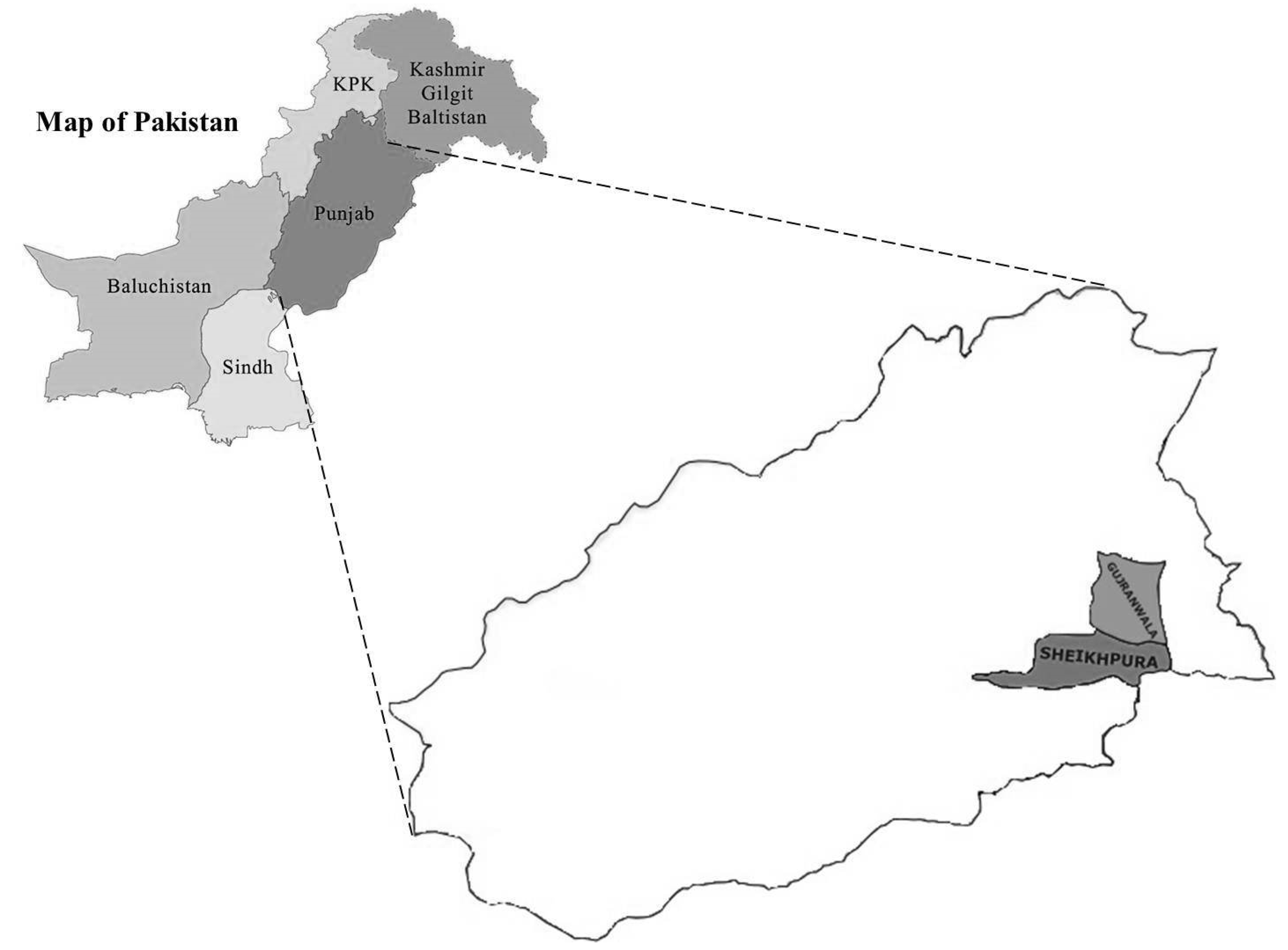
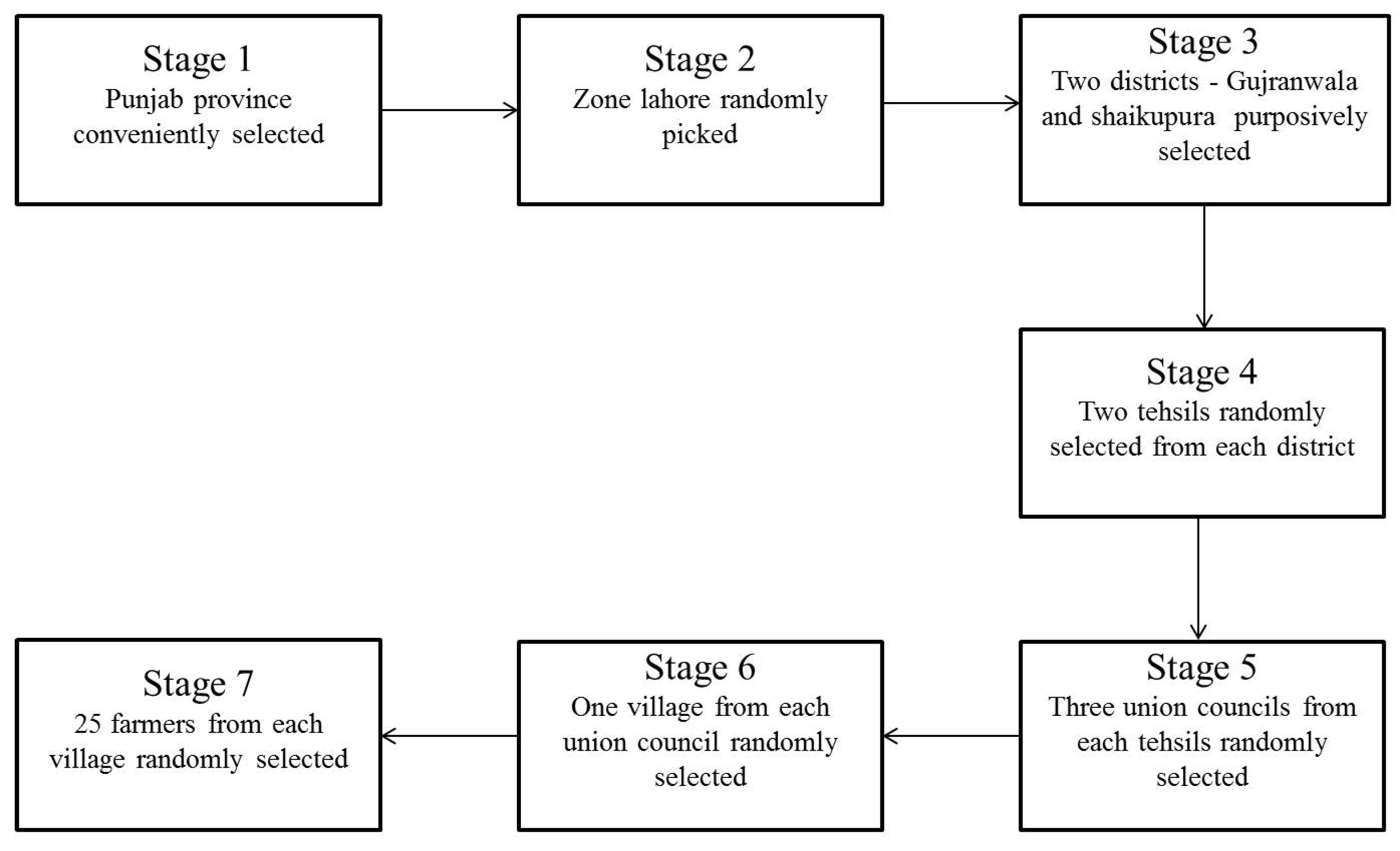
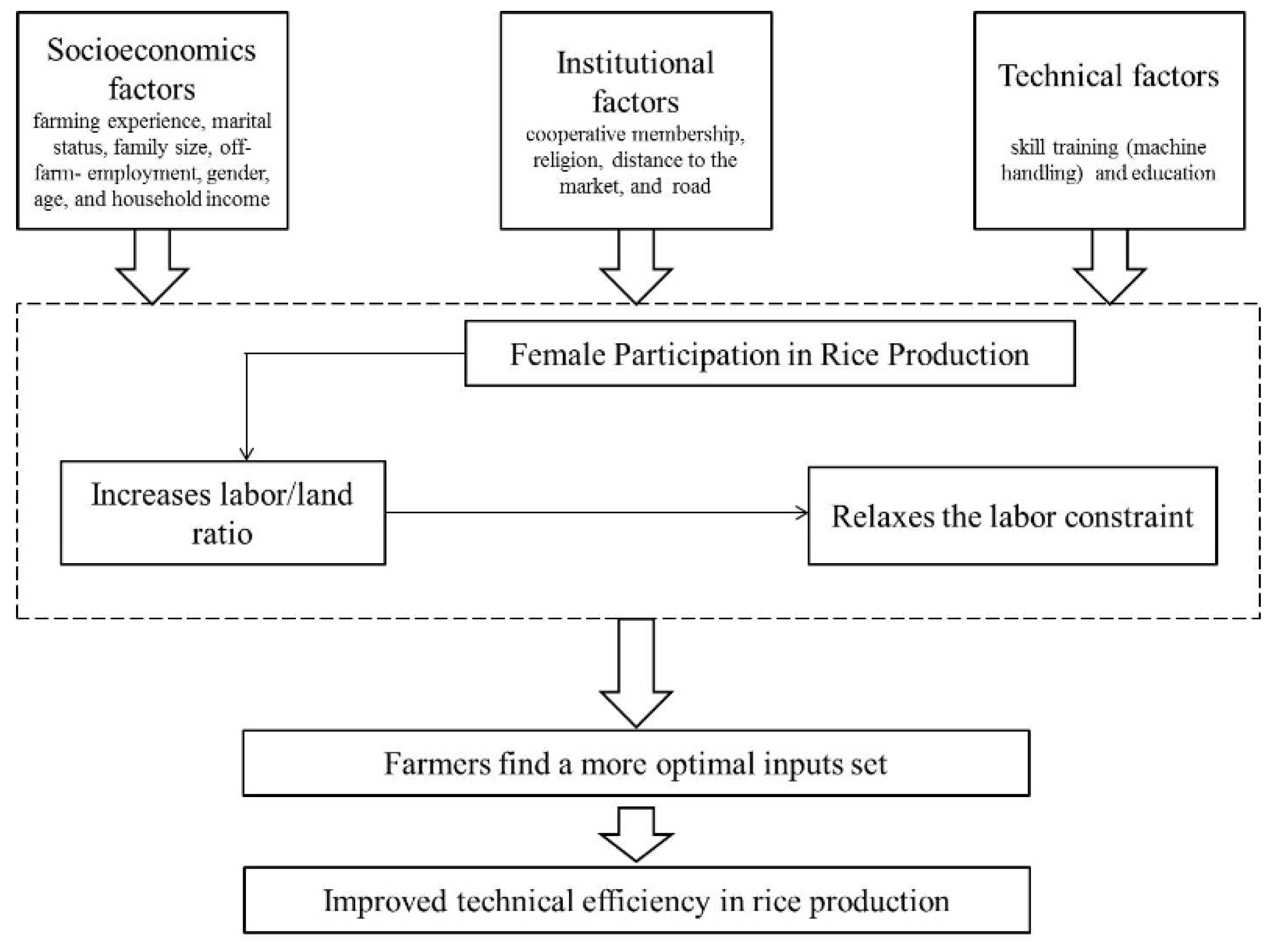
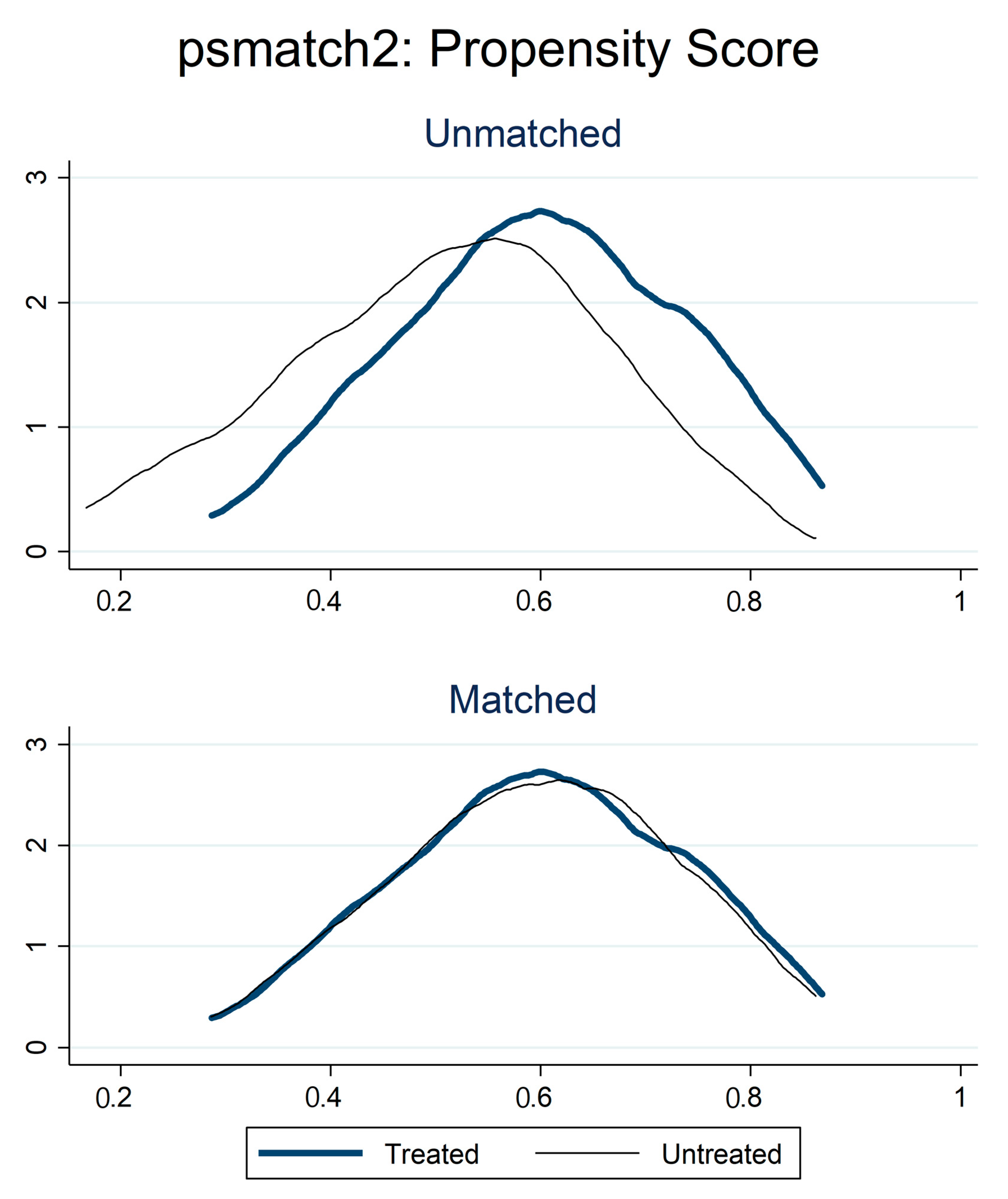
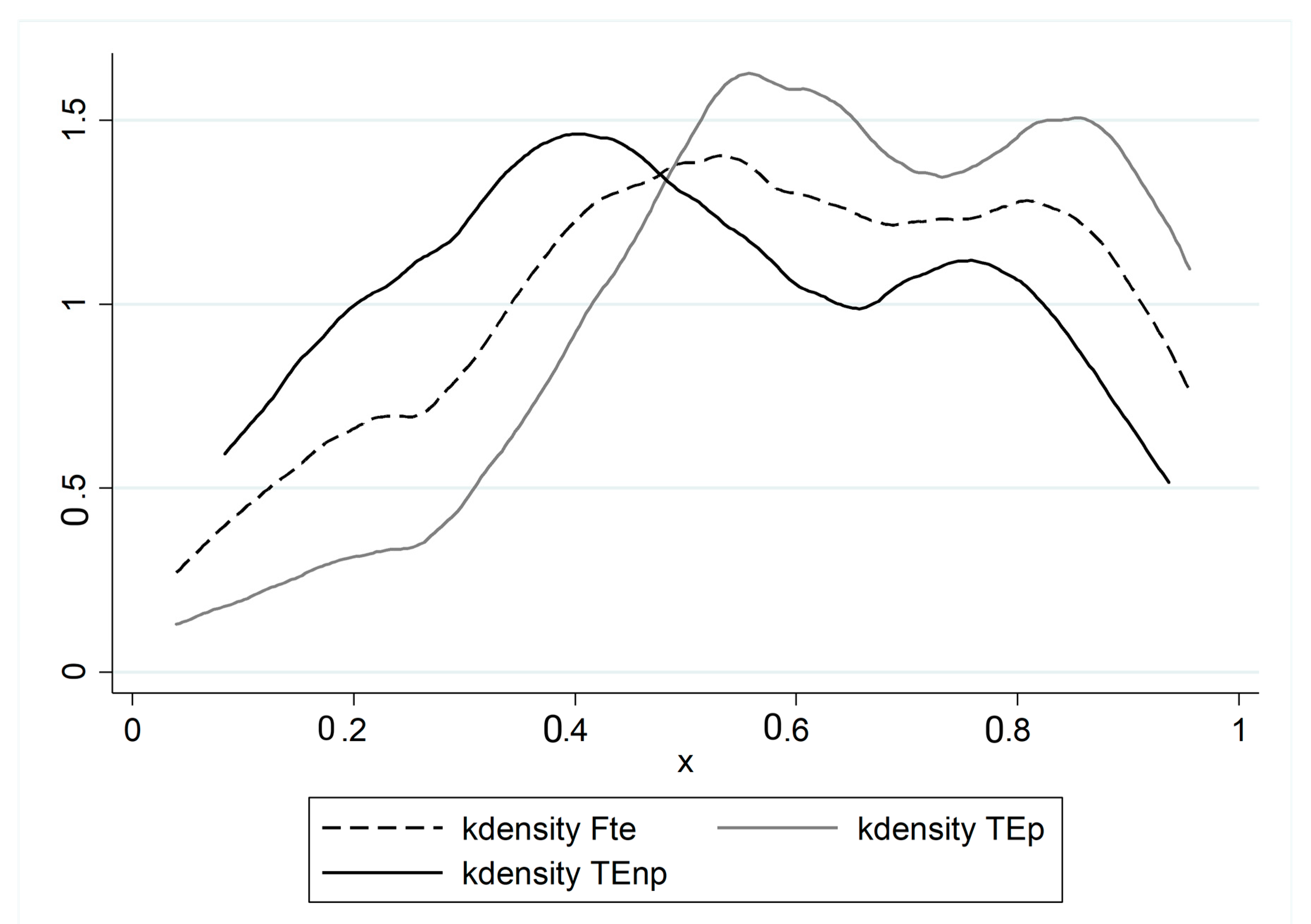
| Variable | Description | Pooled N = 300 | Women’s Participation N = 168 | Without Women’s Participation N = 132 |
|---|---|---|---|---|
| Output | ||||
| Rice output | Rice output in kg | 21580 (700.75) | 14404.76 (553.28) | 30712.12 *** (955.92) |
| Classical inputs | ||||
| Land | Cultivated land for rice in acres | 10.79 (0.35) | 7.20 (0.28) | 15.36 *** (0.44) |
| Fertilizer | Fertilizer used in kg | 150.62 (1.40) | 140.03 (1.29) | 164.09 *** (2.24) |
| Labor | Labor hours used in production | 672.84 (3.82) | 667.50 (5.91) | 679.64 (4.27) |
| Seeds | Rice seeds used in kg | 96.54 (3.95) | 51.40 (2.22) | 154.00 *** (5.32) |
| Explanatory Variable | ||||
| Income | The household income per annum in Pakistani currency (PK.Rs) | 17136.68 (1195.71) | 16934.54 (1816.26) | 17393.94 (1436.44) |
| Member of Cooperative | Membership of a household to a cooperative (1 if a member) | 0.23 (0.02) | 0.20 (0.03) | 0.28 * (0.04) |
| Family Size | Number of members in a household | 4.70 (0.10) | 4.54 (0.13) | 4.89 * (0.15) |
| Market Distance | The distance from the market in kilometers | 23.93 (0.40) | 23.68 (0.50) | 24.24 (0.63) |
| Distance to road | The distance from the house to the main road in kilometers | 22.95 (0.35) | 22.39 (0.43) | 23.67 * (0.58) |
| Gender | Sex of the household head (01 if women) | 0.45 (0.03) | 0.45 (0.04) | 0.44 (0.04) |
| Farming Experience | Number of years of farming experience | 18.62 (0.50) | 18.79 (0.64) | 18.40 (0.78) |
| Marital status | Marital status of household head (1 if married) | 0.88 (0.02) | 0.89 (0.02) | 0.86 (0.03) |
| Education | Number of years of schooling for the household head | 7.24 (0.18) | 6.93 (0.24) | 7.63 * (0.27) |
| Off-farm employment | Engagement of household in off-farm employment (1 if engaged in employment) | 0.58 (0.03) | 0.51 (0.04) | 0.67 *** (0.04) |
| Age | Age of the household head | 42.36 (0.55) | 43.20 (0.74) | 41.30 * (0.80) |
| Machine | Number of machine hours used | 10.78 (0.01) | 10.84 (0.01) | 10.69 *** (0.02) |
| Figure. | Inefficiency Model | ||
|---|---|---|---|
| Classical Inputs | Coef (Std.Err) | Explanatory Variables | Coef (Std.Err) |
| Inlabor | 0.469 * (0.248) | Women’s participation | −0.473 * (0.278) |
| Inland | 0.081 (0.128) | Member of cooperative | 0.122 (0.327) |
| Inseed | 0.238 *** (0.079) | Family size | −0.178 (0.115) |
| Infertilizer | 0.194 (0.184) | Gender | −0.295 (0.276) |
| Constant | 13.694 *** (1.652) | Farming experience | 0.044 * (0.025) |
| Marital status | −0.886 * (0.519) | ||
| Education | −0.012 (0.050) | ||
| Off-farm employment | −0.291 (0.261) | ||
| Machine | 1.926 ** (0.975) | ||
| Constant | −19.301 * (10.577) | ||
| Model Diagnostics | |||
| sigma_u | 0.998 *** (0.207) | Log likelihood | −177.627 |
| sigma_v | 0.116 ** (0.055) | Mean | 0.567 |
| lambda | 8.573 *** (0.180) | N | 264 |
| Item | Description | Mean | ATT | |
|---|---|---|---|---|
| Households with women’s participation | Households without women’s participation | |||
| Land productivity | Rice output per acre in kg/acre | 1535.61 | 814.39 | 721.21 *** (56.38) |
| labor/land ratio | Labor hours per acre | 94.34 | 49.82 | 44.52 *** (3.28) |
© 2020 by the authors. Licensee MDPI, Basel, Switzerland. This article is an open access article distributed under the terms and conditions of the Creative Commons Attribution (CC BY) license (http://creativecommons.org/licenses/by/4.0/).
Share and Cite
Rasheed, A.; Mwalupaso, G.E.; Abbas, Q.; Tian, X.; Waseem, R. Women Participation: A Productivity Strategy in Rice Production. Sustainability 2020, 12, 2870. https://doi.org/10.3390/su12072870
Rasheed A, Mwalupaso GE, Abbas Q, Tian X, Waseem R. Women Participation: A Productivity Strategy in Rice Production. Sustainability. 2020; 12(7):2870. https://doi.org/10.3390/su12072870
Chicago/Turabian StyleRasheed, Abubakar, Gershom Endelani Mwalupaso, Qasir Abbas, Xu Tian, and Rafay Waseem. 2020. "Women Participation: A Productivity Strategy in Rice Production" Sustainability 12, no. 7: 2870. https://doi.org/10.3390/su12072870
APA StyleRasheed, A., Mwalupaso, G. E., Abbas, Q., Tian, X., & Waseem, R. (2020). Women Participation: A Productivity Strategy in Rice Production. Sustainability, 12(7), 2870. https://doi.org/10.3390/su12072870





